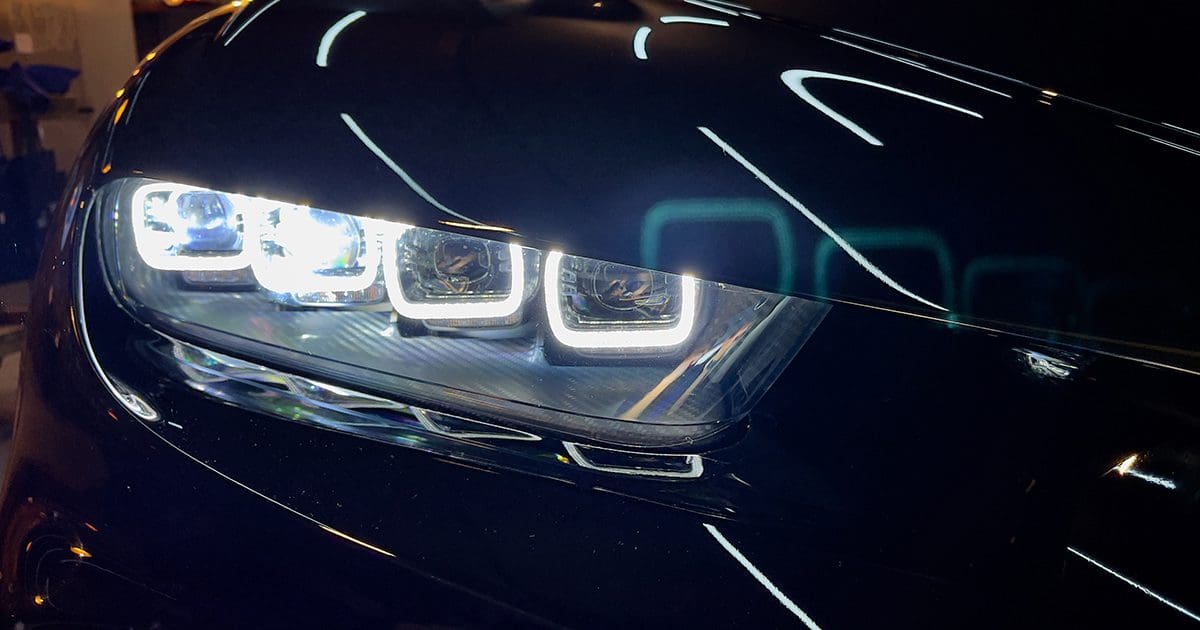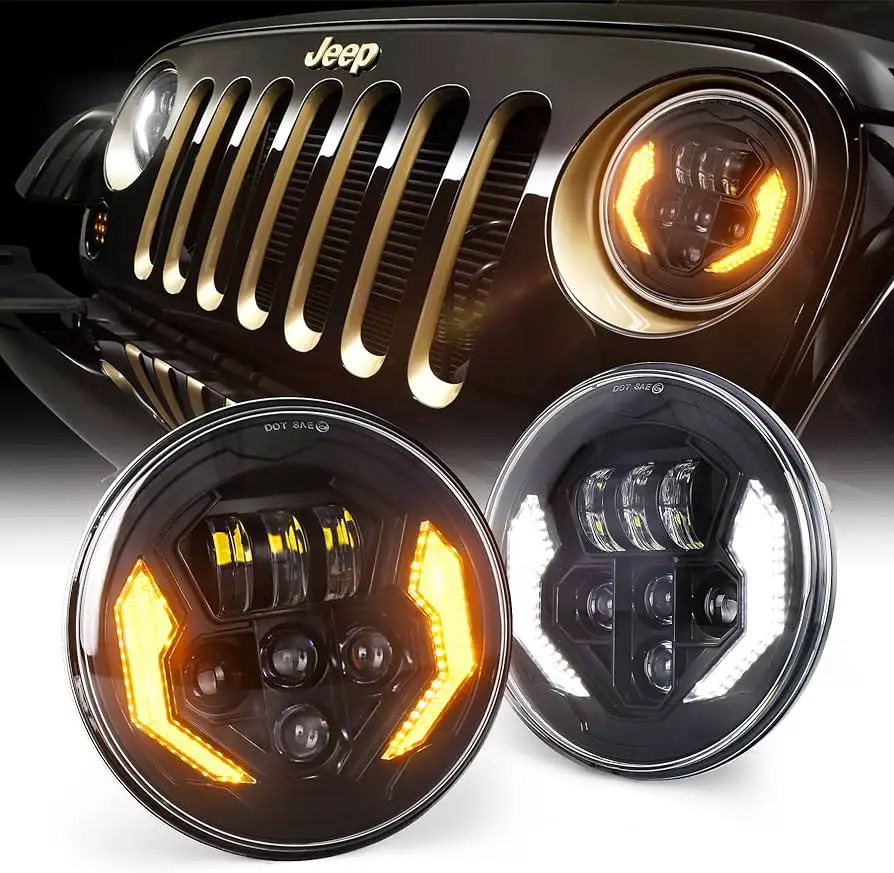Composite headlights are headlights that consist of multiple pieces that can be disassembled, unlike sealed beam headlights which are one-piece. These headlights are commonly used in modern automotive vehicles and are designed to incorporate turn signals and fog lamps into their design.
Composite headlights use a halogen gas-filled environment inside a plastic lens and reflectors. Unlike sealed beam headlights, when a bulb fails in a composite headlight, you only need to replace the bulb instead of the entire assembly. These headlights are integrated aerodynamically into a vehicle’s body, with a housing consisting of a reflective surface covered by a lens.
Composite headlights have revolutionized the way headlights are designed, offering more versatility and convenience in replacing bulbs.
Evolution Of Automotive Headlights
Composite headlights, also known as composite bulbs, consist of multiple pieces that can be disassembled. Unlike sealed beam headlights, where the entire assembly needs to be replaced when the bulb fails, composite headlights allow for individual parts to be replaced.
These headlights also have the ability to incorporate turn signals and fog lamps into their design.
Introduction To The Evolution Of Automotive Headlights
Automotive headlights have come a long way since their inception, evolving to meet the ever-changing needs of drivers and vehicle manufacturers. In this article, we will explore the fascinating journey of automotive headlights and delve into the importance of headlights in vehicle design and safety.
Importance Of Headlights In Vehicle Design And Safety
Headlights play a crucial role in vehicle design and safety, ensuring optimal visibility for drivers and enhanced road safety for all. Let’s take a closer look at the significance of headlights:
1. Enhanced Visibility
Headlights provide the necessary illumination for drivers, allowing them to navigate safely in low-light conditions, such as during dusk, dawn, or at night. By illuminating the road ahead, headlights enable drivers to spot potential hazards, pedestrians, and obstacles early on, reducing the risk of accidents.
2. Improved Safety
Headlights are essential for ensuring the safety of both drivers and pedestrians. By making the vehicle visible to others on the road, headlights serve as a warning sign, preventing collisions and promoting safe driving practices. Additionally, headlights also contribute to the visibility of turn signals, further enhancing safety during lane changes and turns.
3. Innovative Design Integration
With the advent of composite headlights, automotive designers gained the ability to integrate various functional elements seamlessly. Composite headlights can incorporate turn signals and fog lamps into their design, streamlining the overall aesthetic while enhancing functionality. This integration not only improves the vehicle’s appearance but also ensures optimal performance and convenience for drivers.
4. Energy Efficiency And Sustainability
Modern composite headlights often utilize advanced lighting technologies such as halogen, LED, or HID bulbs, offering greater energy efficiency compared to traditional sealed beam headlights. This energy efficiency not only reduces the strain on the vehicle’s electrical system but also contributes to a greener and more sustainable driving experience.
In conclusion, the evolution of automotive headlights has been driven by the pursuit of improved visibility, safety, and design integration. By embracing composite headlights and integrating advanced lighting technologies, vehicles can now offer enhanced visibility, safety, and energy efficiency, providing a better driving experience for everyone on the road.
Understanding Composite Headlights
Composite headlights are the standard in modern vehicles, consisting of multiple pieces that can be disassembled. Unlike sealed beam headlights, when a bulb fails in a composite headlight, you only need to replace the bulb itself. These headlights also have the ability to incorporate turn signals and fog lamps into their design, adding functionality to the vehicle’s lighting system.
Definition and Explanation of Composite Headlights
Composite headlights are a type of automotive headlight that consists of multiple pieces that can be disassembled. Unlike sealed beam headlights, which are all one-piece and require the entire assembly to be replaced when the bulb fails, composite headlights allow for individual components to be replaced, making maintenance and repairs more convenient.How Composite Headlights Differ from Sealed Beam Headlights
The main difference between composite headlights and sealed beam headlights is their construction. Sealed beam headlights are a single unit that contains the bulb, reflector, and lens, and cannot be taken apart. In contrast, composite headlights are made up of separate pieces, including a plastic lens, reflector, and bulb, allowing for easier replacement of individual components. With composite headlights, if the bulb burns out or the lens becomes damaged, only that specific part needs to be replaced, saving both time and money. This modular design also offers greater flexibility for customization, as composite headlights can incorporate turn signals and fog lamps into their design.Advantages and Features of Composite Headlights
There are several advantages and features of composite headlights that make them a popular choice in the automotive industry: 1. Modularity: Composite headlights can be disassembled into individual components, allowing for easy replacement of specific parts. 2. Customization: Unlike sealed beam headlights, composite headlights have the ability to incorporate additional features such as turn signals and fog lamps. 3. Cost-Effective Maintenance: With composite headlights, only the faulty component needs to be replaced, reducing repair costs. 4. Improved Visibility: Composite headlights often use halogen bulbs, which provide a bright and focused beam of light, enhancing visibility on the road. 5. Enhanced Design: The modular design of composite headlights allows for sleek and aerodynamic styling, contributing to the overall aesthetics of the vehicle. In conclusion, composite headlights offer a more convenient and cost-effective solution compared to sealed beam headlights. Their modular design, customization options, and improved visibility make them a popular choice among automakers and car enthusiasts. Whether it’s for maintenance or design purposes, composite headlights provide an efficient and stylish lighting solution for modern vehicles.The Components Of Composite Headlights
Composite headlights, unlike sealed beam headlights, consist of multiple pieces that can be disassembled. This allows for easier maintenance and replacement of individual components. Understanding the different components of composite headlights is crucial for any automotive enthusiast or DIY mechanic. In this section, we will break down the different components of composite headlights, discuss the process of disassembling and reassembling them, and explore the function and purpose of each component.
Breakdown Of The Different Components Of Composite Headlights
Composite headlights are made up of several key components that work together to provide effective and efficient lighting for vehicles. Here is a breakdown of these components:
| Component | Description |
|---|---|
| 1. Housing | The housing is the outer shell of the headlight assembly, typically made of durable plastic or metal. It provides protection for the internal components and helps to maintain the shape and integrity of the headlight. |
| 2. Lens | The lens is the transparent cover that allows light to pass through while protecting the internal components from environmental factors such as dust, debris, and moisture. It also helps to focus the light beam for optimal visibility. |
| 3. Reflectors | Reflectors are located inside the housing and play a crucial role in directing and maximizing the output of light from the bulb. They are designed to reflect the light in a specific pattern, ensuring proper illumination of the road ahead. |
| 4. Bulb | The bulb, often a halogen bulb, is the light source of the headlight assembly. It sits inside the reflector and produces the light that is emitted through the lens. Different types of bulbs can be used, such as halogen, LED, or HID, depending on the desired brightness and energy efficiency. |
| 5. Wiring and Connectors | The wiring and connectors provide the necessary electrical connections between the bulb, power source, and other components of the headlight assembly. They ensure the proper flow of electricity to illuminate the bulb. |
Disassembling And Reassembling Composite Headlights
Disassembling and reassembling composite headlights requires some level of skill and care. Here is a general overview of the process:
- Start by carefully removing any trim pieces or screws that hold the headlight assembly in place.
- Disconnect the wiring and connectors from the back of the headlight assembly.
- Unscrew or release any fasteners that secure the lens or housing to the reflector.
- Gently separate the lens or housing from the reflector, taking care not to damage any of the components.
- To reassemble, simply follow the steps in reverse, ensuring each component is properly aligned and secured.
Function And Purpose Of Each Component
Each component of the composite headlight assembly serves a specific function and contributes to the overall performance and functionality of the headlights. Here is a brief overview of their functions:
- The housing provides protection and structural integrity for the internal components.
- The lens allows light to pass through while providing protection and focusing the light beam.
- The reflectors maximize the output of light from the bulb and direct it in a specific pattern for optimal visibility.
- The bulb serves as the light source, producing the actual light that is emitted through the lens.
- The wiring and connectors ensure the proper electrical connections for the headlight assembly to function correctly.
Understanding the components and their functions can help in diagnosing and resolving any issues that may arise with composite headlights. Whether it’s replacing a bulb, repairing a damaged lens, or upgrading to LED technology, having an understanding of the different components allows for more informed decisions and efficient maintenance.

Credit: www.bestcaraudio.com
Incorporating Advanced Technology In Composite Headlights
Composite headlights are revolutionizing the automotive industry with their advanced technology and innovative features. Unlike traditional sealed beam headlights, composite headlights consist of multiple pieces that can be disassembled, allowing for easier maintenance and bulb replacement. By incorporating advanced technology, composite headlights offer a range of features that enhance both functionality and design.
The Integration Of Turn Signals And Fog Lamps In Composite Headlights
One of the key advancements in composite headlights is the ability to incorporate turn signals and fog lamps into their design. With this integration, vehicles equipped with composite headlights provide enhanced visibility and safety on the road. Turn signals integrated into the headlight assembly ensure that other drivers are alerted when making a turn or changing lanes. Similarly, fog lamps integrated into composite headlights improve visibility in adverse weather conditions, allowing drivers to navigate through fog, rain, or snow with ease.
Advanced Features And Options In Modern Composite Headlights
Modern composite headlights offer a range of advanced features and options that enhance the overall lighting experience. With the use of halogen gas-filled environments inside a plastic lens and reflectors, composite headlights provide improved brightness and clarity. Additionally, some composite headlights are equipped with LED technology, which offers even greater luminosity and energy efficiency. Furthermore, manufacturers have introduced adaptive headlights that dynamically adjust the direction of the light beam based on the vehicle’s speed and steering input, providing optimal illumination and increased safety on the road.
How Composite Headlights Enhance The Overall Design Of Vehicles
Besides their advanced functionality, composite headlights also play a crucial role in enhancing the overall design of vehicles. The aerodynamic integration of composite headlights into a vehicle’s body creates a seamless and sleek appearance. The reflective surface of the housing, covered by a lens, adds a touch of sophistication to the vehicle’s front end. Moreover, the ability to customize the shape and style of composite headlights allows automakers to incorporate them seamlessly into the design language of each vehicle model, ensuring a cohesive and visually appealing aesthetic.
Repairing And Maintaining Composite Headlights
Composite headlights are a common feature in modern vehicles. Unlike sealed beam headlights, composite headlights consist of multiple pieces that can be disassembled and repaired individually. In this section, we will discuss some tips and techniques for repairing and maintaining composite headlights.
Tips And Techniques For Repairing And Maintaining Composite Headlights
When it comes to repairing and maintaining composite headlights, there are a few key tips and techniques to keep in mind:
- Inspect for damage: Begin by inspecting the headlights for any visible damage such as cracks, chips, or moisture buildup. This will help you identify the areas that require immediate attention.
- Replace faulty bulbs: If you notice that one or both of your headlights are not working properly, it is important to replace the faulty bulbs immediately. Be sure to use the appropriate bulb type and follow the manufacturer’s instructions for installation.
- Fix minor cracks and chips: For minor cracks and chips on the headlight lens, you can use a headlight repair kit to fix the damage. These kits usually contain a clear adhesive that helps fill in the cracks and restore the lens’s integrity.
- Seal against moisture: Moisture buildup inside the headlights can cause fogging and reduce visibility. To prevent this, make sure to properly seal any gaps or cracks using a headlight sealant or silicone sealant.
- Polish the lens: Over time, the headlight lens may become cloudy or dull due to oxidation or debris buildup. Use a headlight polishing kit to restore the clarity and brightness of the lens. Follow the kit instructions and take your time to achieve the best results.
Common Issues And Troubleshooting Methods
Even with proper maintenance, composite headlights may still encounter some common issues. Here are a few troubleshooting methods to address these problems:
| Issue | Troubleshooting Method |
|---|---|
| The headlight is dim or flickering | – Check the bulb connections and ensure they are secure – Replace the bulb if necessary – Check the wiring for any signs of damage – Inspect the headlight switch and replace if faulty |
| Moisture buildup inside the headlight | – Check for any cracks or gaps in the lens and seal them properly – Remove the headlight and dry it thoroughly before reinstallation – Use moisture-absorbing packets or silica gel inside the headlight housing |
| Headlight beam misalignment | – Park the vehicle on a level surface in front of a wall – Measure the height and distance between the ground and the center of each headlight – Adjust the headlight beams using the adjustment screws or knobs |
Proper Cleaning And Care For Composite Headlights
To ensure the longevity and performance of your composite headlights, it is important to follow these proper cleaning and care steps:
- Regular cleaning: Clean the headlights regularly using a mild car shampoo and a soft microfiber cloth. Avoid using harsh chemicals or abrasive materials that could scratch the lens.
- Protective coating: Apply a protective coating or wax specifically designed for headlights to provide an extra layer of protection against UV rays and prevent yellowing or hazing.
- Avoid high-pressure washing: When washing your vehicle, avoid using high-pressure washers directly on the headlights. High-pressure water can cause damage to the lens or dislodge any sealants.
- Inspect for debris: Regularly inspect the headlight housing and lens for any debris such as dirt, bugs, or leaves. Remove any dirt or debris promptly to prevent potential damage or reduced visibility.
By following these tips and techniques for repairing and maintaining composite headlights, you can ensure optimal performance and longevity for your vehicle’s lighting system.
Frequently Asked Questions For What Are Composite Headlights
Do Composite Headlights Have Replaceable Bulbs?
Yes, composite headlights have replaceable bulbs. Unlike sealed beam headlights, which require replacing the entire assembly when the bulb fails, composite headlights consist of multiple pieces that can be disassembled for bulb replacement.
What Is A Composite Light Bulbs?
Composite light bulbs, also known as composite headlights, consist of multiple pieces that can be disassembled. They use a halogen gas-filled environment inside a plastic lens and reflectors. Unlike sealed beam headlights, when a composite light bulb fails, you only need to replace the bulb and not the entire assembly.
How Do I Know If I Have Sealed Beam Headlights?
If your vehicle has screws holding a trim piece around the headlight and another metal ring holding the headlight itself, then you have sealed beam headlights. Sealed beam headlights have the bulb, reflector, and lens as one unit.
When Did Composite Headlights Come Out?
Composite headlights were introduced in the automotive industry in the late 1970s.
Conclusion
To sum it up, composite headlights are the standard in today’s automotive industry. Unlike sealed beam headlights, which require the entire assembly to be replaced when the bulb fails, composite headlights consist of multiple pieces that can be disassembled. These headlights offer the advantage of incorporating turn signals and fog lamps into their design, giving car and truck designers more flexibility.
Made from a combination of plastic lenses, reflectors, and halogen gas-filled environments, composite headlights provide a durable and versatile lighting solution for vehicles.



